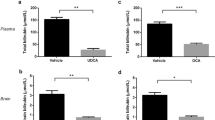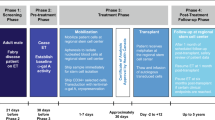Abstract
Gene therapy for inherited disorders might cause an immune response to the therapeutic protein. A solution would be to introduce the gene in the fetal or neonatal period, which should lead to tolerization. Lentiviral vectors mediate long-term gene expression, and are well suited for gene therapy early in development. A model for fetal or neonatal gene therapy is the inherited disorder of bilirubin metabolism, Crigler–Najjar disease (CN). The absence of bilirubin UDP-glucoronyltransferase (UGT1A1) activity in CN patients causes high serum levels of unconjugated bilirubin and brain damage in infancy. CN is attractive for the development of gene therapy because the mutant Gunn rat closely mimics the human disease. Injection of UGT1A1 lentiviral vectors corrected the hyperbilirubinemia for more than a year in rats injected as fetuses and for up to 18 weeks in rats injected the day of birth. UGT1A1 gene transfer was confirmed by the presence of bilirubin glucuronides in bile. All animals injected with UGT1A1 lentiviral vectors developed antibodies to UGT1A1. Animals injected with green fluorescent protein (GFP) lentiviral vectors did not develop antibodies to GFP. Our results indicate that fetal and neonatal gene therapy with immunogenic proteins such as UGT1A1 does not necessarily lead to tolerization.
This is a preview of subscription content, access via your institution
Access options
Subscribe to this journal
Receive 12 print issues and online access
$259.00 per year
only $21.58 per issue
Buy this article
- Purchase on Springer Link
- Instant access to full article PDF
Prices may be subject to local taxes which are calculated during checkout





Similar content being viewed by others
References
Nguyen TH, Ferry N . Liver gene therapy: advances and hurdles. Gene Therapy 2004; 11: S76–S84.
Wang CH, Liu DW, Tsao YP, Xiao X, Chen SL . Can genes transduced by adeno-associated virus vectors elicit or evade an immune response? Arch Virol 2004; 149: 1–15.
Billingham RE, Brent L, Medawar PB . Actively aquired tolerance of foreign cells. Nature 1953; 172: 603–606.
Nossal GJ . Cellular mechanisms of immunologic tolerance. Annu Rev Immunol 1983; 1: 33–62.
Zanjani ED, Anderson WF . Review: Medicine – Prospects for in utero human gene therapy. Science 1999; 285: 2084–2088.
Coutelle C, Themis M, Waddington S, Gregory L, Nivsarkar M, Buckley S et al. The hopes and fears of in utero gene therapy for genetic disease – a review. Placenta 2003; 24: S114–S121.
Waddington SN, Kramer MG, Hernandez-Alcoceba R, Buckley SM, Themis M, Coutelle C et al. In utero gene therapy: current challenges and perspectives. Mol Ther 2005; 11: 661–676.
Waddington SN, Buckley SM, Nivsarkar M, Jezzard S, Schneider H, Dahse T et al. In utero gene transfer of human factor IX to fetal mice can induce postnatal tolerance of the exogenous clotting factor. Blood 2003; 101: 1359–1366.
Waddington SN, Nivsarkar MS, Mistry AR, Buckley SM, Kemball-Cook G, Mosley KL et al. Permanent phenotypic correction of hemophilia B in immunocompetent mice by prenatal gene therapy. Blood 2004; 104: 2714–2721.
Ostrow JD, Mukerjee P, Tiribelli C . Structure and binding of unconjugated bilirubin: relevance for physiological and pathophysiological function. J Lipid Res 1994; 35: 1715–1737.
Tukey RH, Strassburg CP . Human UDP-glucuronosyltransferases: metabolism, expression, and disease. Annu Rev Pharmacol Toxicol 2000; 40: 581–616.
Jansen PL . Diagnosis and management of Crigler–Najjar syndrome. Eur J Pediatr 1999; 158 (Suppl 2): S89–S94.
Ostrow JD, Pascolo L, Tiribelli C . Mechanisms of bilirubin neurotoxicity. Hepatology 2002; 35: 1277–1280.
Chowdhury JR, Kondapalli R, Chowdhury NR . Gunn rat: a model for inherited deficiency of bilirubin glucuronidation. Adv Vet Sci Comp Med 1993; 37: 149–173.
Aubert D, Menoret S, Chiari E, Pichard V, Durand S, Tesson L et al. Cytotoxic immune response blunts long-term transgene expression after efficient retroviral-mediated hepatic gene transfer in rat. Mol Ther 2002; 5: 388–396.
Ailles LE, Naldini L . HIV-1-derived lentiviral vectors. Curr Top Microbiol Immunol 2002; 261: 31–52.
Galimi F, Verma IM . Opportunities for the use of lentiviral vectors in human gene therapy. Curr Top Microbiol Immunol 2002; 261: 245–254.
Trono D . Lentiviral vectors: turning a deadly foe into a therapeutic agent. Gene Therapy 2000; 7: 20–23.
Seppen J, van der RR, Looije N, van Til NP, Lamers WH, Oude Elferink RP . Long-term correction of bilirubin UDPglucuronyltransferase deficiency in rats by in utero lentiviral gene transfer. Mol Ther 2003; 8: 593–599.
van Til NP, Markusic DM, van der Rijt R, Kunne C, Hiralall JK, Vreeling H et al. Kupffer cells and not liver sinusoidal endothelial cells prevent lentiviral transduction of hepatocytes. Mol Ther 2005; 11: 26–34.
Takahashi M, Ilan Y, Chowdhury NR, Guida J, Horwitz M, Chowdhury JR . Long term correction of bilirubin-UDP-glucuronosyltransferase deficiency in Gunn rats by administration of a recombinant adenovirus during the neonatal period. J Biol Chem 1996; 271: 26536–26542.
Stripecke R, Villacres MD, Skelton DC, Satake N, Halene S, Kohn DB . Immune response to green fluorescent protein: implications for gene therapy. Gene Therapy 1999; 6: 1305–1312.
Inoue H, Ohsawa I, Murakami T, Kimura A, Hakamata Y, Sato Y et al. Development of new inbred transgenic strains of rats with LacZ or GFP. Biochem Biophys Res Commun 2005; 329: 288–295.
Morris JC, Conerly M, Thomasson B, Storek J, Riddell SR, Kiem HP . Induction of cytotoxic T-lymphocyte responses to enhanced green and yellow fluorescent proteins after myeloablative conditioning. Blood 2004; 103: 492–499.
Kimura S, Eldridge JH, Michalek SM, Morisaki I, Hamada S, McGhee JR . Immunoregulation in the rat: ontogeny of B cell responses to types 1, 2, and T-dependent antigens. J Immunol 1985; 134: 2839–2846.
Ladics GS, Smith C, Bunn TL, Dietert RR, Anderson PK, Wiescinski CM et al. Characterization of an approach to developmental immunotoxicology assessment in the rat using SRBC as the antigen. Toxicol Methods 2000; 10: 283–311.
Watts AM, Stanley JR, Shearer MH, Hefty PS, Kennedy RC . Fetal immunization of baboons induces a fetal-specific antibody response. Nat Med 1999; 5: 427–430.
Marchant A, Appay V, Van Der SM, Dulphy N, Liesnard C, Kidd M et al. Mature CD8(+) T lymphocyte response to viral infection during fetal life. J Clin Invest 2003; 111: 1747–1755.
Jerebtsova M, Batshaw ML, Ye X . Humoral immune response to recombinant adenovirus and adeno-associated virus after in utero administration of viral vectors in mice. Pediatr Res 2002; 52: 95–104.
Manns MP, Obermayer-Straub P . Cytochromes P450 and uridine triphosphate-glucuronosyltransferases: model autoantigens to study drug-induced, virus-induced, and autoimmune liver disease. Hepatology 1997; 26: 1054–1066.
Clarke DJ, Keen JN, Burchell B . Isolation and characterisation of a new hepatic bilirubin UDP-glucuronosyltransferase. Absence from Gunn rat liver. FEBS Lett 1992; 299: 183–186.
Magdalou J, Antoine B, Ratanasavanh D, Siest G . Phenobarbital induction of cytochrome P-450 and UDP-glucuronosyltransferase in rabbit liver plasma membranes. Enzyme 1982; 28: 41–47.
Kootstra NA, Matsumura R, Verma IM . Efficient production of human FVIII in hemophilic mice using lentiviral vectors. Mol Ther 2003; 7: 623–631.
VandenDriessche T, Thorrez L, Naldini L, Follenzi A, Moons L, Berneman Z et al. Lentiviral vectors containing the human immunodeficiency virus type-1 central polypurine tract can efficiently transduce nondividing hepatocytes and antigen-presenting cells in vivo. Blood 2002; 100: 813–822.
Follenzi A, Battaglia M, Lombardo A, Annoni A, Roncarolo MG, Naldini L . Targeting lentiviral vector expression to hepatocytes limits transgene-specific immune response and establishes long-term expression of human antihemophilic factor IX in mice. Blood 2004; 103: 3700–3709.
Nguyen TH, Bellodi-Privato M, Aubert D, Pichard V, Myara A, Trono D et al. Therapeutic lentivius-mediated neonatal in vivo gene therapy in hyperbilirubinemic Gunn rats. Mol Ther 2005 (in press).
Peters WH, Allebes WA, Jansen PL, Poels LG, Capel PJ . Characterization and tissue specificity of a monoclonal antibody against human uridine 5′-diphosphate-glucuronosyltransferase. Gastroenterology 1987; 93: 162–169.
Seppen J, Tada K, Ottenhoff R, Sengupta K, Chowdhury NR, Chowdhury JR et al. Transplantation of Gunn rats with autologous fibroblasts expressing bilirubin UDP-glucuronosyltransferase: correction of genetic deficiency and tumor formation. Hum Gene Ther 1997; 8: 27–36.
Acknowledgements
This research was made possible by a grant from NWO, 016.026.012 to JS.
Author information
Authors and Affiliations
Corresponding author
Rights and permissions
About this article
Cite this article
Seppen, J., van Til, N., van der Rijt, R. et al. Immune response to lentiviral bilirubin UDP-glucuronosyltransferase gene transfer in fetal and neonatal rats. Gene Ther 13, 672–677 (2006). https://doi.org/10.1038/sj.gt.3302681
Received:
Revised:
Accepted:
Published:
Issue Date:
DOI: https://doi.org/10.1038/sj.gt.3302681
Keywords
This article is cited by
-
Repeated AAV-mediated gene transfer by serotype switching enables long-lasting therapeutic levels of hUgt1a1 enzyme in a mouse model of Crigler–Najjar Syndrome Type I
Gene Therapy (2017)
-
Gene Replacement Therapy for Genetic Hepatocellular Jaundice
Clinical Reviews in Allergy & Immunology (2015)
-
Development of gene transfer for induction of antigen-specific tolerance
Molecular Therapy - Methods & Clinical Development (2014)
-
Alteration of viral lipid composition by expression of the phospholipid floppase ABCB4 reduces HIV vector infectivity
Retrovirology (2008)
-
X-chromosome linked inhibitor of apoptosis protein inhibits muscle proteolysis in insulin-deficient mice
Gene Therapy (2007)



